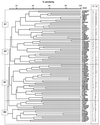Relatedness of Streptococcus suis isolates of various serotypes and clinical backgrounds as evaluated by macrorestriction analysis and expression of potential virulence traits
- PMID: 11158088
- PMCID: PMC87757
- DOI: 10.1128/JCM.39.2.445-453.2001
Relatedness of Streptococcus suis isolates of various serotypes and clinical backgrounds as evaluated by macrorestriction analysis and expression of potential virulence traits
Abstract
We evaluated the genetic diversity of Streptococcus suis isolates of different serotypes by macrorestriction analysis and elucidated possible relationships between the genetic background, expression of potential virulence traits, and source of isolation. Virulence traits included expression of serotype-specific polysaccharides, muramidase-released protein (MRP), extracellular protein factor (EF), hemolysin activity, and adherence to epithelial cells. Macrorestriction analysis of streptococcal DNA digested with restriction enzymes SmaI and ApaI allowed differentiation of single isolates that could be assigned to four major clusters, named A1, A2, B1, and B2. Comparison of the genotypic and phenotypic features of the isolates with their source of isolation showed that (i) the S. suis population examined, which originated mainly from German pigs, exhibited a genetic diversity and phenotypic patterns comparable to those found for isolates from other European countries; (ii) certain phenotypic features, such as the presence of capsular antigens of serotypes 2, 1, and 9, expression of MRP and EF, and hemolysin activity (and in particular, combinations of these features), were strongly associated with the clinical background of meningitis and septicemia; and (iii) isolates from pigs with meningitis and septicemia showed a significantly higher degree of genetic homogeneity compared to that for isolates from pigs with pneumonia and healthy pigs. Since the former isolates are considered highly virulent, this supports the theory of a clonal relationship among highly virulent strains.
Figures



References
-
- Arends J P, Zanen H C. Meningitis caused by Streptococcus suis in humans. Rev Infect Dis. 1988;10:131–137. - PubMed
-
- Chanter N, Jones P W, Alexander T J L. Meningitis in pigs caused by Streptococcus suis—a speculative review. Vet Microbiol. 1993;36:39–55. - PubMed
-
- Clifton-Hadley F A. The epidemiology, diagnosis, treatment and control of Streptococcus suis type 2 infection. In: McKean J D, editor. Proceedings of the American Association of Swine Practioners. Minneapolis, Minn: American Association of Swine Practioners; 1986. pp. 471–491.
Publication types
MeSH terms
Substances
LinkOut - more resources
Full Text Sources
Other Literature Sources
Medical
Molecular Biology Databases

